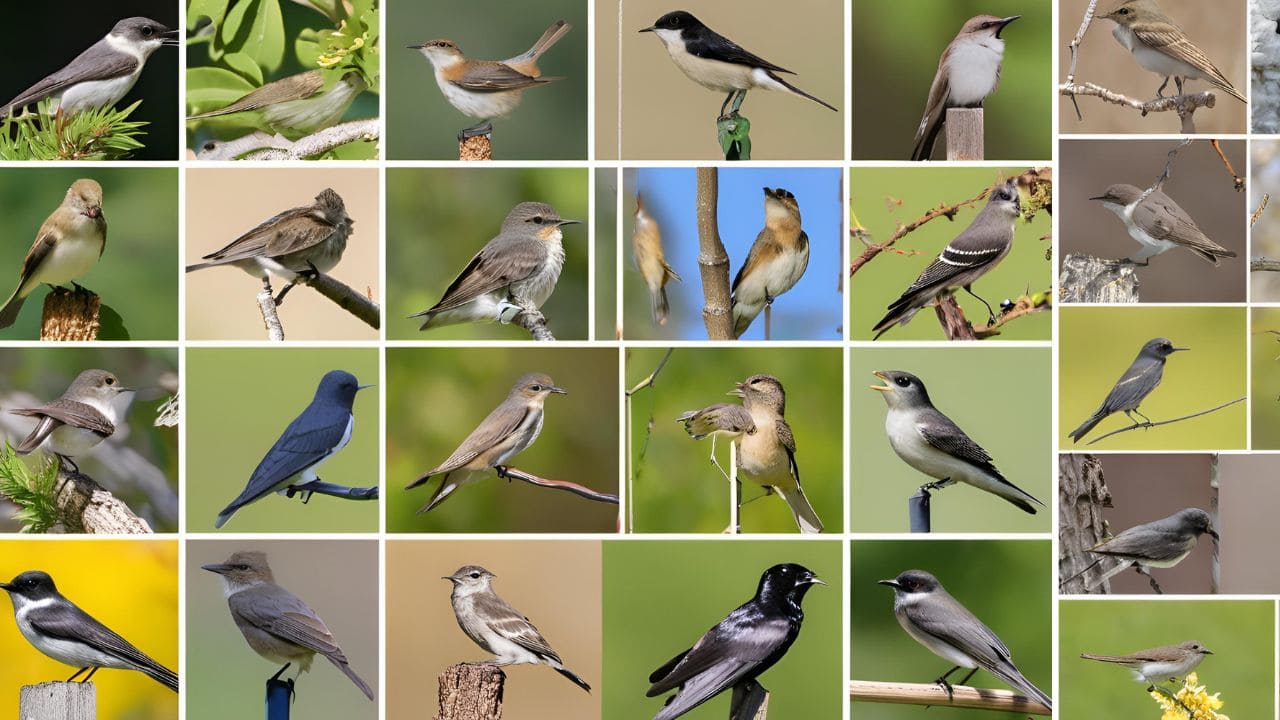Table of Contents
What are mosquito eating birds?
The birds which feed on mosquitoes and some even on their larvae are called mosquito eating birds. Therefore, the existence of such birds is helpful and advantageous in curbing the number of mosquitoes to some degree. These birds do not only rely on mosquitoes as their food, but they also prey other insects and pest in your garden and back yard.
In this article, we will concentrate on the subtypes of birds that are known to feed on mosquitoes, what other components of diet they have and also how to lure such birds that feed on mosquitoes.
What birds eat mosquitoes?
There are hundreds of species that can be termed as mosquito eaters; the nighthawk, purple martin, American robin etc. are the ones most well-known. To put the necessary context to the connection between gorged moose and birds awaiting to feast on them, a summary has been prepared which elaboratively captures such birds along with the respective areas of habitation. Most of them are native to North America, while some of them are from Europe and Asia.
How to invite these birds to your garden or yard?
To attract birds that eat mosquitoes we can make following changes and adapt to most suitable and bird friendly environment in our garden or yard, as this will help in attracting these mosquito eating birds.
- Provide trees, shrubs, low lying branches and tall plants, as a perching and roosting spots.
- Keep clean birdbath with fresh water to attract birds, specially in hot and warmer days.
- Install bird feeders and offer seeds, mashed fruits, berries, suet, mealworms, etc.
- Platform feeders will attract mainly Purple martins and swallows which are very effective in controlling mosquito population.
- Install specially designed nest boxes for different birds like tree swallows, bluebirds, etc. As for Chipping Sparrow, bird houses with small opening is preferred.
- Avoid pesticides to provide natural insect population to feed them.
- Plant trees native to their origin as they will bear fruits and berries as per their diets.
- Left open space like meadows and yards as many of these birds prefer to live in open.
- Add hanging roots and fences near water sources as perching spots.
- Install birdhouse for birds that eat mosquitoes or encourage them to build nest by providing them ideal nesting spots.
- Plant hedges, and bushes with small boxes as shelter areas for roosting at night.
22+ Birds that eat mosquitoes
Many birds are good at eating mosquitoes and have good appetite for not only mosquitoes but many other insects as well. They are easy to attract and may require different methods to attract different mosquito eating birds. Find below some most useful bird species that are beneficial against controlling population of mosquitoes and their larvae.
1. Purple Martin

Image Credit: Flickr by Andrew Reding | Content License
Purple martins are usually found throughout the North America, eastern and central US. These are migratory birds and fly around 150 to 500 feet above the ground. These are the largest swallow in the swallow family. They do not nest in natural regions or cavities like trees, they usually nest in man made housings and depends mainly on humans for their nesting.
They mainly feed on flying insects out of which mosquitoes are the rare ones, as mosquitoes are found near the ground surface and between dense vegetation. Also, mosquitoes rarely come outside in day time, when martins are out for food search.
They refrain from going out when there are extended periods of cold weather where temperature falls below 48o F or when it is raining.
What they eat:
Their majority of the diet includes bees, wasps, beetles, flying ants, mayflies, etc., while hardly 2% of their diet includes mosquitoes.
How to attract Purple Martin:
Installing multi-compartment bird-houses in open areas. They occasionally eat ants on the ground and they can attracted by mealworms, when kept in an open feeder.
2. Barn Swallow

Image Credit: Flickr by Lip Kee | Content License
The Barn swallow (Hirundo Rustica) is the most common of all swallows and are found in all parts of the world, specially North America. They love to live in open land like barns, pastures, meadows and farmland which are nearby any water source. They avoid dense and heavily built-up locations.
They prefer man-made nesting sites like outside of buildings, under bridges, etc. It builds a cup nest made of mud pellets, hair and other materials and prefer to live along with humans.
They can eat up to 1000 insects per day, primarily mosquitoes. Hence, they are tolerated by humans, and they implement means to attract these swallows in their garden and backyard.
What they eat:
The barn swallows are good at eating flying insects like mosquitoes, large flies, aphids, grasshoppers, crickets, dragonflies, beetles and moths.
How to attract Barn Swallow:
Install bird houses in the open like in garden or backyard or leave barns open for nesting.
3. Eastern Kingbird

Image Credit: Flickr by Kelly Colgan Azar | Content License
The eastern kingbird is migratory native to the Americas, where it breeds in North America and in winters they flew to Central and South America. They are known for their aggressiveness and keenness to protect their nests and surroundings. These are dark colored birds with white underbelly and pointed wings. They prefer to make their nests in open and generally found near bushes and scattered trees.
What they eat:
They can eat hundreds of insects including mosquitoes everyday. They also eat berries and fruits in winters, when it is difficult to go out for searching insects.
How to attract Eastern Kingbird:
You can keep open spaces and planting native plants that can attract insects to feed them. They also prefer to stay around water so, installing bird bath will also attract them.
4. Common Nighthawk
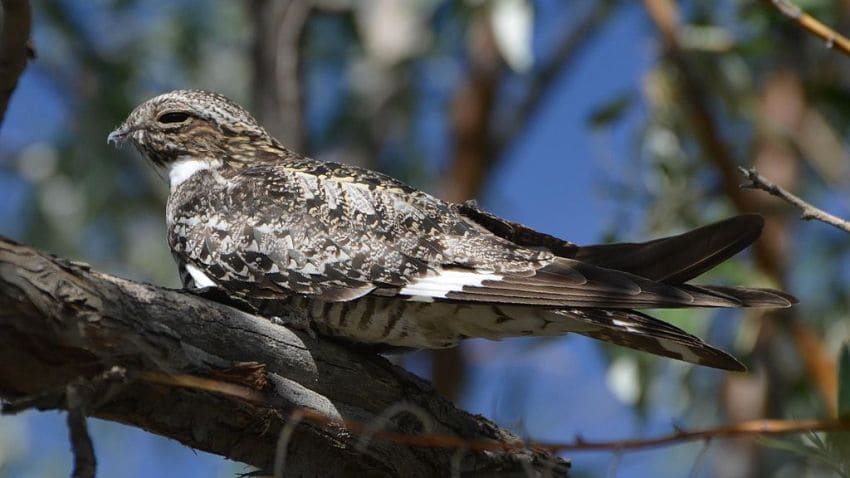
Image Credit: Wikimedia by Andy Reago & Chrissy McClarren | Content License
Common Nighthawk as the name suggests are not strictly nocturnal and even not closer to hawks. They are mainly found in deserts, forest, savannahs, beach, urban cities, prairies, etc. They are native to America and they breeds in North America in summers, and for winters they migrate to South America. They are insectivores and feed on many other insects including mosquitoes. They are also called as “bugeaters” or “bull-bat”. They prefer to live in open and large areas but they are attracted to urban built-up areas by insects
What they eat:
They eat many different insects including mosquitoes. They need a proper and constant food source for their survival.
How to attract Common Nighthawk:
Warmer temperatures and sufficient food supply by maintaining an insect-rich environment without any use of pesticides. They prefer large open spaces bigger than backyard.
5. Tree Swallow

Image Credit: Flickr by Virginia State Parks | Content License
Tree Swallows are native of North America and also found in Canada, and parts of US like California, New Mexico, Kansas, Alaska, etc. They migrates to Central and South America during winter. They have a glossy blue-green feathers on the back with a light colored underbelly.
They prefer to live in open habitats around trees near water bodies like meadows, beaver ponds, wooded swamps, lakes, marshes or wetlands. They are known for their cheerful chirping and melodious sounds.
They nests in pre-existing natural and man made cavities, usually in cavities of trees, in hollow stumps, under the eaves of buildings, artificial nest boxes, etc. They make cup nests by using grass, moss, pine needles, and aquatic plants, which is also lined with feathers.
In cold weather due to lack of sufficient insect population, most of them starve to death. The tree swallows lays up to 4 to 7 eggs in each season which then needs incubation for around 14 to 15 days.
What they eat:
They are aerial insectivore and eat mainly insects like flies, including spiders, mosquitoes, mollusks, ants, and some fruits.
How to attract Tree Swallow:
They can be attracted by installing nest boxes or bird houses in open fields near water body and maintaining an insect-friendly environment.
6. Yellow Warbler
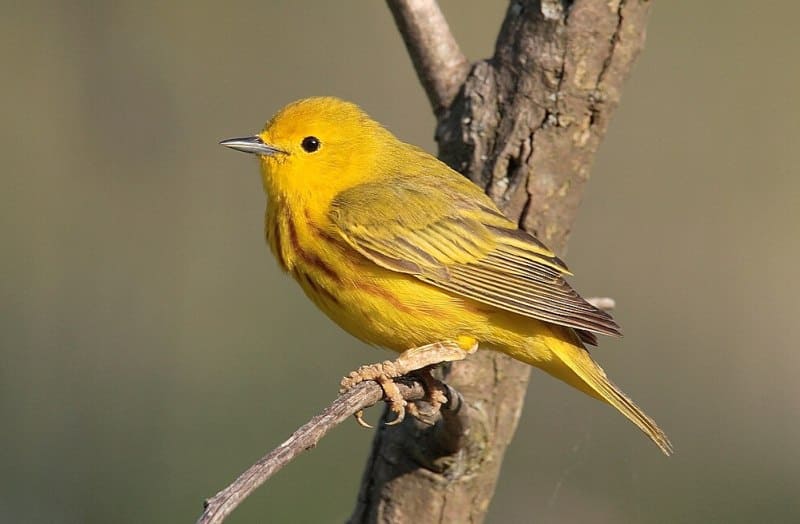
Image Credit: Wikimedia by Mdf | Content License
The Yellow Warbler is a small bright yellow colored bird found in North America, the Caribbean and Central America. They prefer to live around forest edges, open fields and woodlands. More commonly found in the mangrove swamps of the West Indies. The American yellow warblers come to the less dense and suburban regions with less human settlement areas, orchards, parks etc. for breeding.
The yellow warblers make small and sturdy cup nests. They usually lay up to 4 to 6 eggs in a season, while incubation takes around 11 to 14 days.
Their sweet whistling song and vocal and cheerful presence along with insect and mosquito population control, contributes towards a pleasing environment and healthy ecosystem.
What they eat:
They eat mostly caterpillars along with other insects like wasps, moths, mosquitoes, beetles, mayflies, treehoppers, spiders and insect larvae. Their diet also includes few berries and juicy fruits.
How to attract Yellow Warbler:
These warblers can be attracted by planting native trees, shrubs, along with water features like ponds, bird baths, etc. Also, maintaining organic garden will help in maintaining the insect population for providing them sufficient food source.
7. Chimney Swift
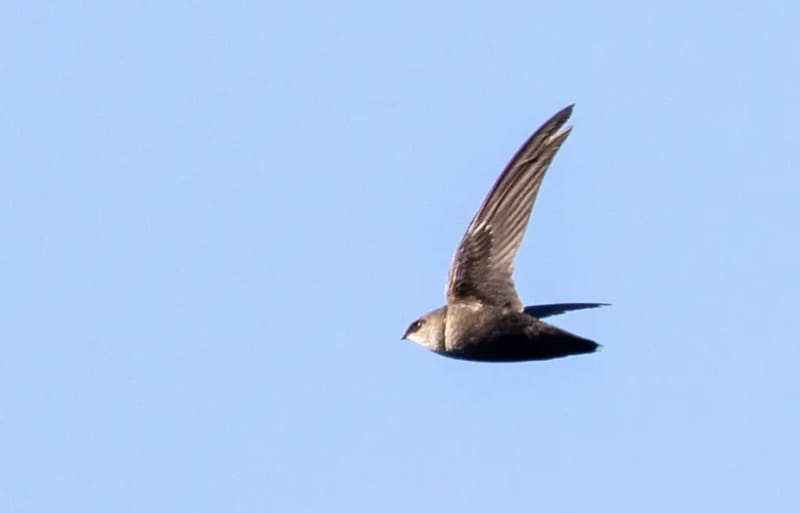
Image Credit: Animalia.bio | Content License
Chimney swifts are native to North America and for winters they migrate to South America. They are known for their cigar shaped bodies and since they are found making shelters in chimneys, they are called Chimney swifts.
They have a grayish dusty brown color with long curved wings and short tails. they are migratory birds and travel long distances. They spend most of the time flying in the air and feed mainly on flying insects including mosquitoes. They lay 4 to 5 eggs, while hatching takes another 19 days.
They can only perch on vertical surfaces and not on flat surfaces. They quickly take shelter or invade old and abandoned chimneys, that mimics the natural habitat of hollow tree.
They make human built structures like chimneys for nesting. They use twigs and saliva to stick the nests on the vertical walls inside of a chimney. They can adapt well in urban environments with human settlements.
What they eat:
They mainly feed on flying insects like flies, ants, wasps, bees, aphids, mayflies, etc. including mosquitoes.
How to attract Chimney Swift:
They can be attracted by installing swift towers in gardens, and caps to pre-existing chimneys.
8. House Wren
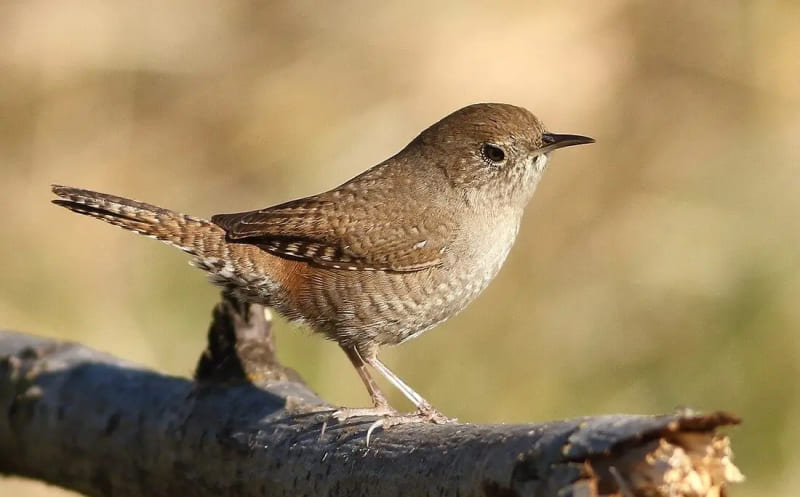
Image Credit: Animalia.bio | Content License
House Wren are tiny small songbirds that are found in North and South America. They have brown colored back with light underbellies. they prefer to live around woodlands, gardens, and suburban areas with human settlements. They are most commonly found in backyards in western hemisphere.
They are known for their energetic and active behavior and sing loudly and frequently. And they communicate with sharp loud calls. They prefer building nests in tree cavities and bird houses. They make their nests using twigs, grass and feathers. They may take over nests from other birds as well.
What they eat:
They eat insects like beetles, flies, moths, crickets, spiders, grasshoppers, caterpillars, snails and ants.
How to attract House Wren:
To attract House wren you can place simple nest boxes with small entrance, and place them around shrubs or thickets. Limit the use of insecticide in your garden and backyard to provide ample supply of insects for their feeding.
9. American Robin
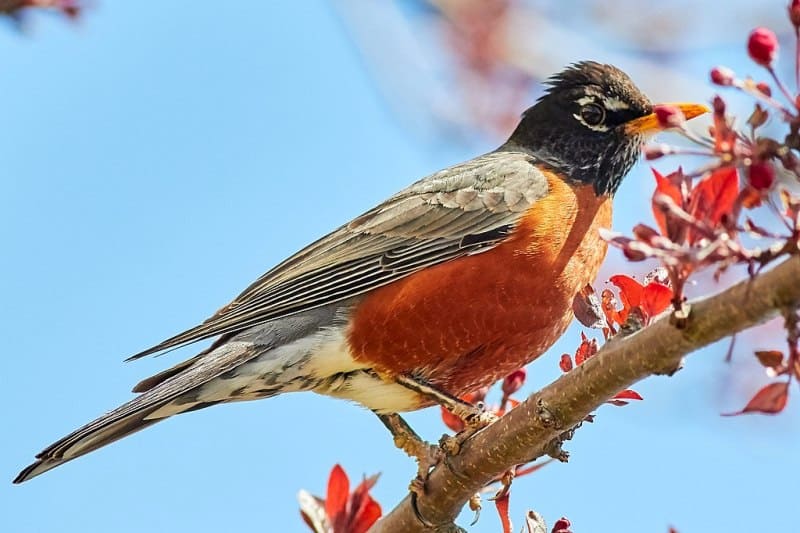
Image Credit: Wikimedia by Jongsun Lee | Content License
American Robin is mainly found in Canada and Mexico and many other parts of North America. They prefer to live ion open and green habitats like forest, fields, gardens, etc. In the winter they migrate to warmer regions in South America and Central America.
They easily adapt to different environments and can live in urban and rural landscapes like farms, parks, gardens, etc. In warmer regions they come to ground for search of food mainly insects like worms, ants, beetles, mosquitoes, and many other pests. In winter and fall, when there are not much insects they switch on feeding fruits and berries.
They build sturdy cup nests using twigs, grass and mud. They build nests on trees, shrubs, and eaves of building roof. They lay approx. 3 to 5 eggs in a season. They are medium-sized songbirds which sings melodious songs and communicate with sweet vocal calls and songs.
What they eat:
They eat mainly worms and insects including mosquitoes. They also eat fruits and berries when there is not much insects available as like in winter season.
How to attract American Robin:
To attract American Robin, you must provide them food and shelter. You can build nest boxes or at least provide them some safe space for building nests. As they prefer to eat worms from soils, you can leave uncovered patches of soil with worms. They also eat berries and fruits for which you can plant fruit bearing shrubs and trees for an alternative source of food. In addition to this you can install a bird bath that will be a point of center as they prefer to bath frequently.
10. Bluebirds

Image Credit: Google Images | Creative Commons License
The different varieties of Bluebirds are found which are widely distributed across North America. Eastern Bluebirds are found in the Great Plains of the Atlantic, Western Bluebirds in the Western U.S. including California, and Mountain Bluebirds in the rocky mountains within U.S. from Alaska to Mexico.
the eastern bluebird is the most widely seen species and can be found in your backyard birdbaths, bird houses, etc. They are small bright colored songbirds, known for singing melodic cheerful songs.
They prefer to live in open spaces like forest edges, woodlands, meadows, orchards, fields, and pastures either in suburban or rural areas. In winters, these bluebirds migrate the southern regions and if they have got plenty of food supply they prefer to stay within their breeding range.
They build their nests in tree holes and cavities. and often relies on old woodpecker holes or man made nest boxes. They construct nests using grass, feathers and pine needles. They lay approx. 3 to 6 eggs in a season which takes around 2 weeks of incubation to hatch
What they eat:
They are insectivore and prefer to eat insects like grasshoppers, caterpillars, beetles, mosquitoes, etc. In winters when insects are rarely found, they prefer to eat fruits and berries like sumac, holly etc.
How to attract Bluebirds:
You can place nest boxes in open areas away from dense trees and vegetation. In breeding season you can offer mealworms with suet, and berries to attract these bluebirds. Planting native fruit-bearing shrubs and installing birdbaths with clean water will encourage them to visit your garden or backyard.
11. Eastern Phoebe

Image Credit: Flickr by Shenandoah National Park | Content License
The Eastern Phoebes are most commonly found in eastern U.S., and southern parts of Canada. In winter season, they migrate to warmer regions like southern U.S., and Mexico. They prefer to live around water streams in open places like forests, farmlands, meadows, especially around human settlements near barns, sheds, pastures, etc.
They belong to tyrant flycatcher family and mainly depend on insects for food.
They make their nests using moss, grass, and mud especially near manmade structures like barns, bridges and houses which are typically close to water sources. They lay around 2 to 6 eggs in a season, which needs around 16 days of incubation.
What they eat:
They mainly eat flying insects like flies, grasshoppers, mosquitoes, as well as beetles and occasionally eat berries and small fruits when there are not much insects as in winters.
How to attract Eastern Phoebe:
To attract these bluebirds, provide number of perching spots like fences or trees where they can catch insects. Installing a ledge on barn or shed or any typical structure with ledge in your backyard will encourage them to build nest.
They don’t often visit or feed on bird feeders and therefore it is important to maintain an insect friendly environment. Don’t use pesticides as this will reduce the number of insects that they feed on.
12. Hummingbird

Image Credit: Pexels by Theodore Ferguson | Content License
Hummingbirds are the smallest birds in the world and there are more than 300 species. They are native to Americas, mainly South and Central America and found all around America from Alaska to Tierra del Fuego. They are known for their tiny size and pointed long beaks with extremely high wingbeats up to 80 per second. They can easily hover and fly in all directions including backwards.
They prefer to live in habitats with plenty of flowers such as gardens, parks, open nurseries, meadows, etc. They make nest of a walnut size on trees or shrubs, preferably from plant fibers, moss, lichen, spider silk, etc. They lay 2 to 3 tiny eggs in a clutch which they incubate for next 2 to 3 weeks.
What they eat:
They have a very high metabolism and therefore they need to eat frequently. They mainly feed on nectar from flowers and plants. They also eat small insects like flies, mosquitoes, spiders, etc.
How to attract Hummingbird:
They are attracted to tubular flowers in varied bright colors particularly red and orange. Plant native flowering plants in plenty of quantity as they feed on 1000 flowers per day. Install hummingbird feeders with a solution of water and sugar (4:1). Don’t add honey or artificial sweetener or sugar as this will harm them.
Provide perching spots like small branches between flowers, as they take rest frequently in between while feeding. Also, maintain insect friendly environment for them to feed on insects.
13. Carolina Chickadee

Image Credit: Flickr by U.S. Fish and Wildlife Service Headquarters | Content License
Carolina Chickadee are native to the southeastern parts of United States. They are known for their distinct “chick-a-dee-dee” call. They easily adapt to various environmental conditions and can be found near human settlements. They are most commonly seen in forests, farmlands and near human populated areas like parks, backyards, all over from Maryland to Texas.
They make their nests in tree holes or cavities and abandoned woodpecker holes and also near human settlements. They use fur, feathers, moss and other soft materials for building nest. They lay around 5 to 8 eggs per clutch which needs incubation for further 12 to 13 days.
They are playful and acrobatic and seen hanging upside down on branches of trees. Frequently visit backyards with long trees and shrubs which can give protection from invasion and falling prey to other predators.
What they eat:
They primarily feed on insects like spiders, beetles, caterpillars, including mosquitoes. In winters they switch and feed on seeds, nuts, berries and fruits. They also hide seeds in crevices for later consumption in winters.
How to attract Carolina Chickadee:
You can install birdfeeders to attract them and offer sunflower seeds, suet, peanuts etc. Place nest boxes and plant native fruit-bearing trees and shrubs that produce seeds and berries to attract them. They also need dense vegetation like tall trees and bushes as they want a nesting place safe and secure from predators.
14. Northern Cardinal

Image Credit: Flickr by Andrej Chudý | Content License
Northern Cardinal are native to North and Central America, and they are found all over from Canada to northern Argentina, including northern Mexico. They are non migratory birds and often seen in pairs. Males are bright red in color while females are brown with reddish tinge.
They aggressively defend their nest and territory. They are early morning singers and have a variety of sweet calls and songs.
They get easily adapted to various environments and prefer to live in gardens, shrublands, farmlands, and suburban areas, etc. Hence they are frequent visitor to gardens and backyards. They make cup shaped sturdy and firm nest in hidden spots within thick vegetation and low trees not higher than 10 feet using twigs, leaves, grasses, and bark strips.
What they eat:
They love to eat fruits, grains, berries and seeds, the sun flower seeds being the most favorite. During breeding season they need protein and hence they supplement their diet with insects like caterpillars, beetles, grasshoppers, mosquitoes, etc. They can easily crack hard seeds with their strong thick beaks.
How to attract Northern Cardinal:
To attract Northern Cardinals place birdfeeders in your yard or garden filled with sunflower or safflower seeds. Plant native trees and shrubs that bear berries and seeds to attract them. They prefer quiet and far from crowd place to build their nest around dense trees and shrubs. Installing fresh water bird bath will also encourage them to visit your backyard.
15. Baltimore Oriole
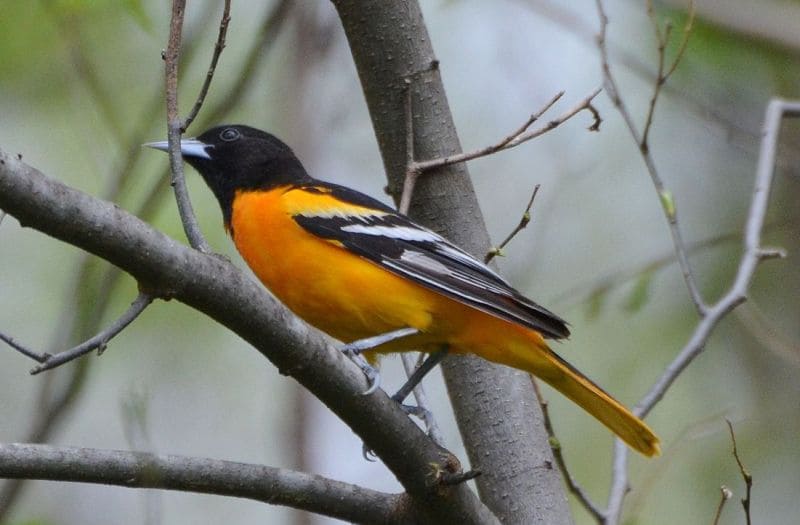
Image Credit: Wikimedia by Andy Reago & Chrissy McClarren | Content License
Baltimore Orioles are native to the eastern and central regions of North America. During breeding season, they are found all over America and in winter they migrate to Central America and southern Northern America. They prefer to live in open habitats like woodlands, forest edges, and even gardens in human populated areas that have tall trees.
They build very distinctive type of hanging woven nests which resembles a woven pouch. For nest making they use grass, plant fibers and strings. They prefer to build nests on tall deciduous trees like oak, maple, or elm at a height of more than 20 to 30 feet.
They lay around 3 to 7 eggs per clutch which needs incubation of 12 to 14 days.
What they eat:
They mainly eat insects like caterpillars, ants, beetles, etc. and also mosquitoes to a very limited extent. They also eat fruits and berries including grapes, oranges and cherries. They eat mainly sugary foods like plant nectar and sweet fruits.
How to attract Northern Warbler:
They are attracted to plant nectar and so offer them sugary nectar juice. Offer them berries, fruits, nectar and insects. You can set up a bird feeder with orange slices, nectar juice, mashed grape, etc. Plant native trees and shrubs like mulberries and blackberries. Fresh water in birdbaths will encourage them to visit your backyard. Availability of tall trees nearby will provide them ideal nesting spots.
16. Chipping Sparrow

Image Credit: Flickr by Jamie Chavez | Content License
Chipping Sparrows are found all over North America. In winters they migrate to southern regions of United States, Mexico, and Central America. They are known for their sharp constant chipping call. They prefer to live in variety of environments like open farmlands, grassy areas, urban parks and gardens. And therefore they are also found in abundant around human habitation.
They make small sturdy cup-shaped nest using grasses, roots and animal hair in low trees and shrubs. They lay 3 to 5 eggs in a clutch and incubation takes another 10 to 12 days. They are ground foragers and mainly depend on insects in summers.
What they eat:
Their diet mainly includes seeds, grains, small plants and insects. During breeding season they feed mainly on Insects like ants, beetles, caterpillars, mosquitoes, spiders, etc. In winter they rely mainly on small seeds like millet.
How to attract Chipping Sparrow:
To attract Chipping Sparrows you can place bird feeders with small seeds like millets. They are attracted to open grassy areas with scattered trees and shrubs, like your garden and yard. Keeping low trees and shrubs to provide them with nesting spots and having a grass cover in your garden with birdbaths will be more inviting for them.
17. American Goldfinch

Image Credit: Pexels by Aaron J Hill | Content License
American Goldfinches are most commonly seen in United States, southern Canada, and some parts of Mexico. They prefer to live in open spaces like meadows, fields, and areas with human settlements like gardens and parks. These are social birds mostly seen in flocks, and they don’t bother to defend their territories.
They make cup-shaped sturdy and compact nest using plant fibers, grasses and spider silk. They lay 4 to 6 eggs which needs incubation of 12 to 14 days.
They are acrobatic and playful and can bee seen often hanging upside down. They molt twice a year, in summer they have bright yellow feathers and in winter they molt into a dull brown plumage.
What they eat:
Goldfinches primarily feed on seeds like sunflower, weed seeds, dandelion, thistle or nyjer seeds, etc. During breeding season they also eat insects like ants, spiders, mosquitoes, caterpillars, etc.
How to attract Goldfinch:
To attract goldfinches you should place bird feeders with variety of seeds including sunflower seeds and nyjer seeds (thistle). Allow dandelions and other seed producing plants to grow in your garden.
18. Hooded Warbler
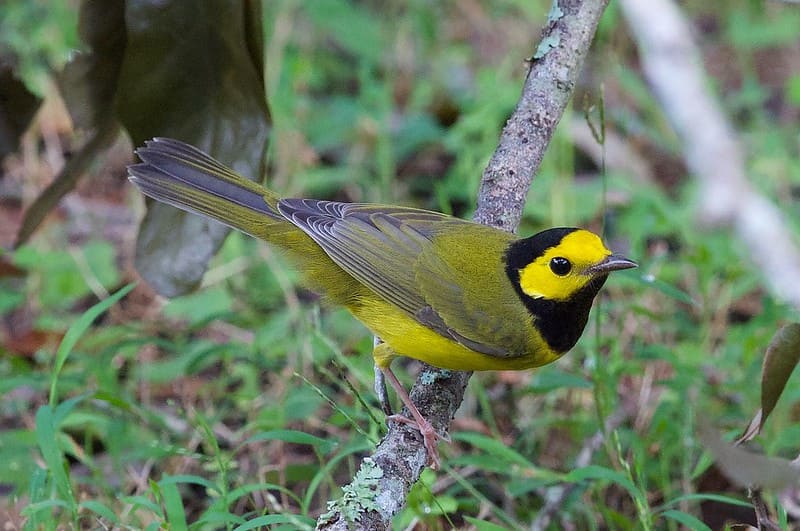
Image Credit: Flickr by Brandon Trentler | Content License
Hooded warblers are mainly found in the eastern parts of North America. In winter they migrate to central America and the Caribbean. Male warblers have a black hood around their neck while females don’t have any hood. They prefer to inhabit in dense deciduous forests. They are insectivorous and mainly depends on spiders, caterpillars, mosquitoes, etc.
They prefer to build nest near the ground in low trees and shrubs. They build cup-shaped nest using grass, leaves and spider web silk, etc. They chose isolated quiet space for nest building to be safe and protected from predators like snake, squirrel, etc. They lay 3 to 5 eggs in a clutch and it takes 12 to 13 days of incubation to get hatched.
What they eat:
Mainly eat insects like spiders, caterpillars, mosquitoes, beetles, etc. They hop on the ground and hunt for insects and also mosquitoes in mid-air with the help of their quick reflexes.
How to attract Hooded Warbler:
Plant dense shrubs and small trees to provide them protective cover. A water source like afresh water bird bath will be more inviting for them. As they mainly feed on insects, maintain insect friendly environment without using pesticides.
19. Indigo Bunting
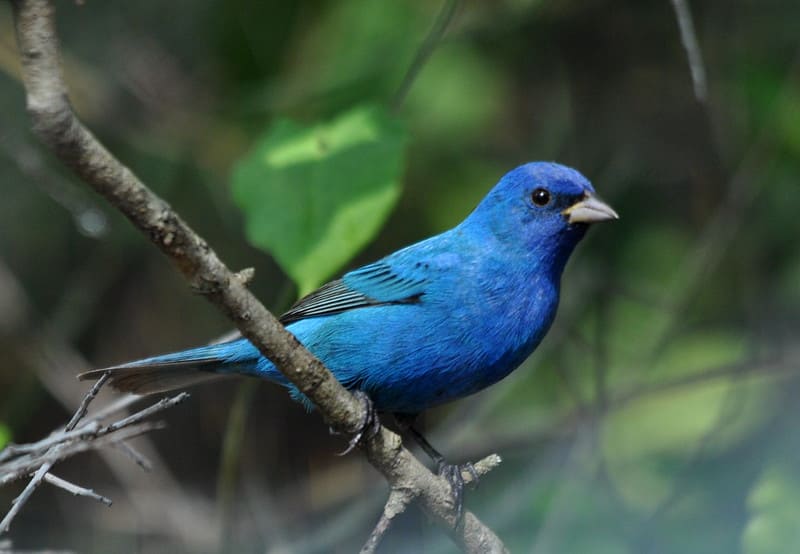
Image Credit: Flickr by Dawn Scranton | Content License
Indigo Buntings are native of North America and can also be seen in eastern and central parts of United States. In winter, they migrate to Central America and parts of the Caribbean. These birds prefer to live in semi-open habitats like woodlands, forest edges and fields.
They have a vivid indigo blue color and known for their cheerful and melodious song. They are diurnal and most active during the day and while migrating they often travel at night, using stars for navigation.
They make cup-shaped nest in low lying branches using grasses, leaves and animal hair. They lay 3 to 4 eggs in a clutch and incubates for around two weeks.
What they eat:
During summer they primarily feed on insects like grasshoppers, beetles, caterpillars and mosquitoes. In colder months of winter due to lack of sufficient insects they switch to berries, seeds and grains.
How to attract Indigo Bunting:
Plant native trees and shrubs that are food bearing and seed producing. Offer them berries, grains and seeds in a bird feeder along with sunflower and nyjer seeds. Provide dense coverage to encourage them to build nest. Install bird baths as a source of fresh water which will encourage them to visit your garden or yard. Avoid using pesticides as they depend mainly on insects.
20. Red-eyed & White-eyed Vireo
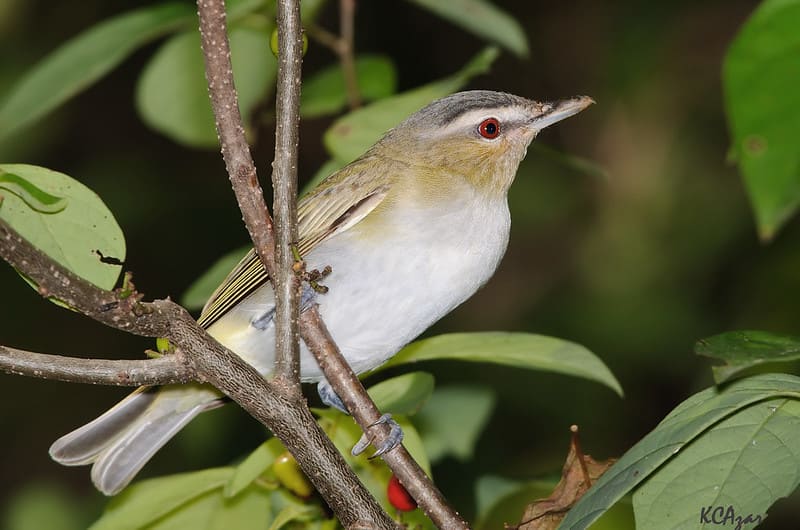
Image Credit: Flickr by Kelly Colgan Azar | Content License

Image Credit: Wikimedia by nate steiner | Content License
Both Vireos are native to North America and can be seen all around Canada, eastern and central U.S. White eyed vireos are seen mainly within southeastern US. In winter, both of these species migrate to Central and South America. The Red-eyed vireo can travel long enough to amazon basin.
They prefer to live in shrubby dense thickets and over grown areas. The Red-eyed vireo mostly hunt for insects in the upper canopy of trees, while white-eyed vireos prefer to stay in dense shrubs foraging mainly on insects close to the ground.
The Red-eyed Vireos prefer to build their nests high in dense trees by using grasses, bark strips and spider silk, etc. While the White-eyed Vireos prefer nests built lower in the shrubs. They both lay 3 to 4 eggs in a clutch and incubation takes about two weeks.
What they eat:
Both vireos are insectivores and depends on insects like beetles, spiders, mosquitoes, ants, etc. They also eat berries and small fruits in winter when insects are not seen much due to cold weather.
How to attract White-eyed & Red-eyed Vireo:
Provide dense trees and shrubs coverage to encourage nesting in your yard. Plant native fruit bearing shrubs and offer berries and mashed fruits to attract them in your yard. Create a natural habitat like overgrown garden space with dense shrubs and bushes with low lying trees.
21. Acadian Flycatcher
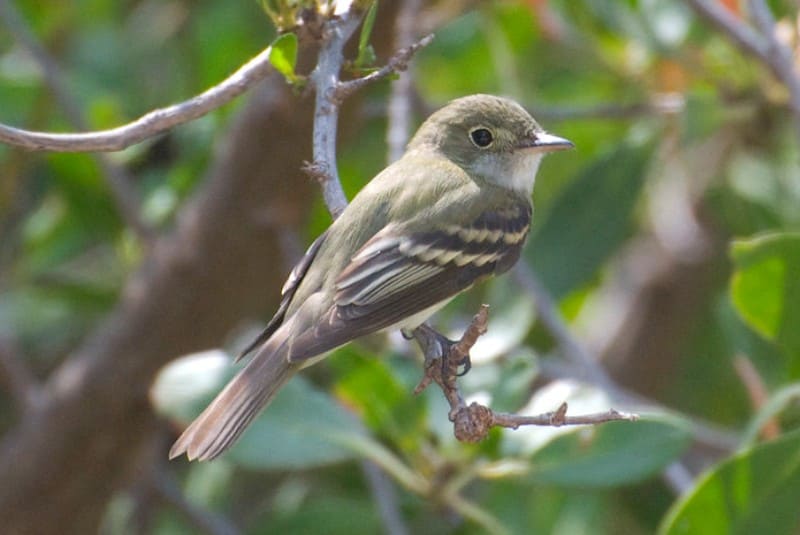
Image Credit: Flickr by Jeff B | Content License
Acadian Flycatchers are primarily found in eastern united States and southeastern Canada and allover in North and South America. They are small in size and belongs to tyrant flycatcher family. They prefer to live in dense forest around deciduous trees near water sources like rivers or streams. They migrate to tropical forest regions of Central and South America for winters.
They prefer to build their nest on tree branches at moderate heights. The nests are cup-shaped and made using grasses, twigs, bark, lined with feathers or moss. They lay around 2 to 4 eggs in a clutch and needs incubation of 2 weeks.
What they eat:
They mainly feed on flying insects like moths, flies, spiders, mosquitoes, beetles, etc. They may also feed on berries and small fruits in colder climates, when insects are not much available.
How to attract Acadian Flycatcher:
It is important to build an insect friendly environment to attract these Acadian Flycatchers. These birds are more likely to live in dense forest like regions rather than any garden or yard. But still in any nearby location if you have tall trees and dense thick vegetation with overgrown cover and sufficient supply of insects than they can be easily invited for feeding and bathing. They mainly avoid urban areas with human settlements. They do not prefer to eat from bird feeders.
22. Veery

Image Credit: Wikimedia by Rhododendrites | Content License
Veeries are commonly found in the North America and also in southern parts of Canada and northern region of United States. They prefer to live around tall deciduous trees and dense forests. In winters, they migrate to the tropical forests of Amazon basin in South America. In winters they can also be seen in Brazil and Bolivia. They can sing flute-like songs
They make their nest in dense vegetation close to the ground using twigs, leaves, grass, moss, etc. The nest is built well inside thick vegetation, hidden and protected from predators. They lay 3 to 4 eggs per clutch and the incubation lasts for around 10 to 12 days.
What they eat:
Their diet mainly consists of insects and small invertebrates, like caterpillars, beetles, moths, ants and spiders. They also eat fruits and berries in late summer. They use hop and pause technique to hunt for insects, mainly on the forest floor.
How to attract Veery:
Keeping a natural undisturbed habitat with dense shrubs and low vegetation and lots of insect-life along with berries and fruits is a key to attract veeries in your backyard. Plant native shrubs that produce berries and small fruits. They prefer elderberry and dogwood mainly. Bird baths are also beneficial as they prefer to live around water source.
23. Western Tanager

Image Credit: Flickr by Jacob McGinnis | Content License
Western Tanagers are medium sized birds with bright yellow to green colored feathers and orange to red colored heads, and belong to cardinal family. They are native of North America, and more commonly found in western United States, and some parts of Canada. They prefer to live in coniferous forests in mountainous regions.
In winters they migrate to Central America and southern Mexico. While migrating they can be seen in woodlands and gardens near urban areas. They build their nest high in coniferous trees using twigs, roots and grasses.
They lay 3 to 5 eggs and the incubation lasts up to 13 days.
What they eat:
They mainly eat insects like caterpillars, beetles, ants, mosquitoes; and in fall they eat berries and small fruits like elderberries and blackberries.
How to attract Western Tanager:
Grow native fruit bearing shrubs in your yard and maintain healthy insect life. They prefer to live in dense foliage and therefore maintaining a thick cover of shrubs and trees and overgrown grass will help in attracting these western tanagers. Build fresh water birdbaths and insect feeders to encourage them to build nests.
Conclusion
There are many birds which are mainly insectivorous and feeding on insects but in actual they may not eat mosquitoes to that extent to reduce or control their population. We must think of reducing the population at larval stage itself. Keep the water in birdbaths clean and avoid other standing water bodies to allow any larvae infestation. However it should be noted that many of these birds are used in different pest control programs, and they also helps in seed dispersing and pollination.
Few of these birds can help in controlling mosquito population and they can be helpful in maintaining the ecosystem of your garden. And also in controlling other pests like ants, beetles, spiders, etc. that may harm your plants.
Which birds eat mosquitoes other than these? There are few common birds especially the farm birds or pet birds that eat mosquitoes like chickens, and goose or duck (called as waterfowl).

